|
Chessville
logo by
ChessPrints


Advertise
with
Chessville!!
Advertise to
thousands
of
chess
fans
for
as little
as $25.
Single insert:
$35
x4 insert:
@ $25 each.

From the
Chessville
Chess Store



From the
Chessville
Chess Store
|
Here's what was New at Chessville between
1 April 2007 and 30 June 2007
(6/30)
Nuestro Círculo #256:
30 de junio de 2007,
dedicado al Gran Maestro
Ucraniano
Alexander Markovich Konstantinopolsky
(1910 - 1990). Aparte de su biografía y partidas, publicamos las notas
"Partidas de un Maestro", "el Aguafiestas" y "Partidas premiadas entre 1896
y 1900."
Nuestro Círculo, un boletín semanal de ajedrez editado en Argentina en lenguaje
español.
|
(6/30)
Alekhine's Parrot:
Welcome to the
weekly leader of chess events around the world.
Chessville welcomes your Feedback to TheParrot on
this week’s news where selected letters will be featured.
This week: Stalin's Ghost, Goddesschess, brains,
banks, and 70,000 children;
Ivanchuk, Khalifman and Kramnik.
TheParrot Squaawks asks: Arbiters are OK too?
|
.jpg)
|
(6/26)
Tactics, Tactics, Tactics...:
Chessville Problem Master Gary Gifford announces a portal page for all our
tactic-related offerings here at Chessville. If studying tactics is
your thing, this is the page to check out for everything from basic concepts
to problems of the week to free downloadable databases of problems, to...
 (6/24)
Chess Instruction:
Watch Your Back...Rank! by IM Igor Khmelnitsky. "Back
rank checkmate is rather unique attacking situation where one doesn’t really
need many pieces to finish the game on the spot. No matter what the material
balance is, what other targets and threats are, if one has a Queen, or even
a Rook and the other side has the King stuck on the back rank (1st
for White or 8th for Black), there is always a chance for a game
ending back rank checkmate. Many tactical operations are based on the
back rank checkmate. Among them elimination of defender, deflection/decoy,
skewer etc… It is amazing, how the situation can turn 180 degrees in a
single move because of the back rank problem. In fact, in my new book
Chess Exam Tactics,
I list Back rank amongst the 6 critical Motives or reasons for
combinations.
Here is an
example from a recent game of my student..." (6/24)
Chess Instruction:
Watch Your Back...Rank! by IM Igor Khmelnitsky. "Back
rank checkmate is rather unique attacking situation where one doesn’t really
need many pieces to finish the game on the spot. No matter what the material
balance is, what other targets and threats are, if one has a Queen, or even
a Rook and the other side has the King stuck on the back rank (1st
for White or 8th for Black), there is always a chance for a game
ending back rank checkmate. Many tactical operations are based on the
back rank checkmate. Among them elimination of defender, deflection/decoy,
skewer etc… It is amazing, how the situation can turn 180 degrees in a
single move because of the back rank problem. In fact, in my new book
Chess Exam Tactics,
I list Back rank amongst the 6 critical Motives or reasons for
combinations.
Here is an
example from a recent game of my student..." |
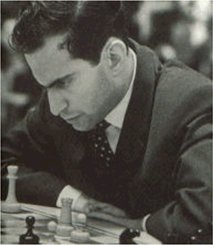 (6/24)
Annotated Game:
Vasily Smyslov
-Mikhail Tal, Candidates Tournament 1959, by Prof. Nagesh Havanur.
"The Candidates' Tournament 1959 was one of the greatest triumphs of Tal's
career. It was a star-studded field with eight players: Smyslov, Keres,
Petrosian, Tal, Gligorich, Benko, Olafsson and a 16-year-old Bobby Fischer!
(Misha beat him 4-0 !) The event began rather ominously for Tal with
losses to Smyslov and Keres. But he picked up pace with courage and
confidence. By the end of the second cycle it was already clear that
the real struggle for the first place lay between Tal and Keres..." (6/24)
Annotated Game:
Vasily Smyslov
-Mikhail Tal, Candidates Tournament 1959, by Prof. Nagesh Havanur.
"The Candidates' Tournament 1959 was one of the greatest triumphs of Tal's
career. It was a star-studded field with eight players: Smyslov, Keres,
Petrosian, Tal, Gligorich, Benko, Olafsson and a 16-year-old Bobby Fischer!
(Misha beat him 4-0 !) The event began rather ominously for Tal with
losses to Smyslov and Keres. But he picked up pace with courage and
confidence. By the end of the second cycle it was already clear that
the real struggle for the first place lay between Tal and Keres..." |
|
 (6/24)
Review: Mikhail Tal
8th World Champion (CD) from Convekta Ltd., reviewed by Prof. Nagesh Havanur.
"28th May,1992.
The traditional Moscow Blitz Tournament is in full swing. The field is
led by World Champion Kasparov himself who has beaten one opponent after
another. But this time there is a kind of electricity in the air.
Seated opposite him is a pale emaciated figure who appears to be a shadow of
himself. It is only the burning eyes that offer a glimpse of the fire
within. For it is none other than Mikhail Tal, former World Champion
and a legendary player in his own time. The crowd watches with bated
breath. Few are aware that the Latvian genius is critically ill and
nearer death's door than ever before. In fact he has sneaked out of
the hospital to participate in his beloved tournament. The play begins
and Kasparov is soon treated to a hussar-like cavalry charge. It
appears that the World Champion is going to be mated. The alert Garry
beats off the dashing attack, retaining the extra material.... only to
overstep the time limit! A stunned Kasparov extends his hand in
congratulation. Pandemonium breaks out in the hall..... That
game was to be Tal's swan song. A month later, on 28th June
1992 he breathed his last in a Moscow hospital and was buried in his native
Riga, the city that he loved. The maestro is gone, but the magic still
lingers..." This review includes two fully annotated games,
including Smyslov-Tal,
Candidates Tournament 1959. (6/24)
Review: Mikhail Tal
8th World Champion (CD) from Convekta Ltd., reviewed by Prof. Nagesh Havanur.
"28th May,1992.
The traditional Moscow Blitz Tournament is in full swing. The field is
led by World Champion Kasparov himself who has beaten one opponent after
another. But this time there is a kind of electricity in the air.
Seated opposite him is a pale emaciated figure who appears to be a shadow of
himself. It is only the burning eyes that offer a glimpse of the fire
within. For it is none other than Mikhail Tal, former World Champion
and a legendary player in his own time. The crowd watches with bated
breath. Few are aware that the Latvian genius is critically ill and
nearer death's door than ever before. In fact he has sneaked out of
the hospital to participate in his beloved tournament. The play begins
and Kasparov is soon treated to a hussar-like cavalry charge. It
appears that the World Champion is going to be mated. The alert Garry
beats off the dashing attack, retaining the extra material.... only to
overstep the time limit! A stunned Kasparov extends his hand in
congratulation. Pandemonium breaks out in the hall..... That
game was to be Tal's swan song. A month later, on 28th June
1992 he breathed his last in a Moscow hospital and was buried in his native
Riga, the city that he loved. The maestro is gone, but the magic still
lingers..." This review includes two fully annotated games,
including Smyslov-Tal,
Candidates Tournament 1959. |
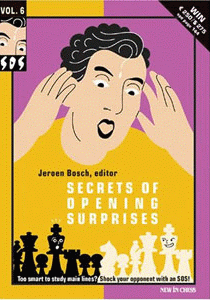 (6/24) Review:
Secrets of Opening Surprises Volume 6 (New
In Chess, 2007), reviewed by Rick Kennedy. "The name is Bland.
James Bland. I find the 3.ed ed French Defense... bracing. Carl
Schlecter's face looks down upon me from a poster in my cubicle. Beneath it
lies a placard: "A half point saved is a half point earned." Words to live
by. My mind reels and my palms sweat at the excitements of... the exchange
Slav Defense. At night I dream of being alone with Halle Berry... playing
the Petroff. You must realize that I have absolutely no need for
Jeroen Bosch's new book, Secrets of Opening Surprises Volume 6.
As far as I am concerned, the so-called openings his authors have put
together deserve to remain forever -- buried, sequestered, secret.
They are too raw. Too brutal. (Deep breath. Let it out
slowly. Another one. There now.) The book reads like a
nightmare, a Reader's Digest of fever dreams. It is bad enough that
there is notation and fulsome explanation in each chapter – there are horrid
little diagrams, as well!..." (6/24) Review:
Secrets of Opening Surprises Volume 6 (New
In Chess, 2007), reviewed by Rick Kennedy. "The name is Bland.
James Bland. I find the 3.ed ed French Defense... bracing. Carl
Schlecter's face looks down upon me from a poster in my cubicle. Beneath it
lies a placard: "A half point saved is a half point earned." Words to live
by. My mind reels and my palms sweat at the excitements of... the exchange
Slav Defense. At night I dream of being alone with Halle Berry... playing
the Petroff. You must realize that I have absolutely no need for
Jeroen Bosch's new book, Secrets of Opening Surprises Volume 6.
As far as I am concerned, the so-called openings his authors have put
together deserve to remain forever -- buried, sequestered, secret.
They are too raw. Too brutal. (Deep breath. Let it out
slowly. Another one. There now.) The book reads like a
nightmare, a Reader's Digest of fever dreams. It is bad enough that
there is notation and fulsome explanation in each chapter – there are horrid
little diagrams, as well!..." |
|
(6/24)
Annotated Game: ChessChat Rotation Game Continues - This game is being played actively on the
ChessChat group,
between Weldon MacDonald, David Surratt, Greg Turner,
Dave "Grobler2001", and Graham "Mad Aussie" Clayton. Play began May
25, 2007. The following position has been reached so far:
|
|
(6/23)
Alekhine's Parrot:
Welcome to the
weekly leader of chess events around the world.
Chessville welcomes your Feedback to TheParrot on
this week’s news where selected letters will be featured.
This week: New Marshall, Old Brady, USCF broker, Short on
FIDE, Rybka, Aerosvit, Gorenje,
Politiken.
TheParrot Squaawks asks what constitutes a real
agenda for USCF's prime mission and reason to exist?
|
.jpg)
|
(6/23)
Nuestro Círculo #255:
23 de junio de 2007,
dedicado al Gran Maestro
Internacional finlandés Eero Einar Böök (1910-1990). Aparte de su biografía
y partidas, publicamos las notas "Difundir el ajedrez", "Najdorf en la
Habana" y la clásica del "Aguafiestas".
Nuestro Círculo, un boletín semanal de ajedrez editado en Argentina en lenguaje
español.
|
(6/17) Alexander the Great:
GM Ray Keene, OBE, is back with a look at the only chess World Champion to
die in possession of the title, Alexander Alekhine. "WITH
Garry Kasparov in the news again, partly as a result of his literary
activities and partly as a result of his arrest in Moscow following his
attendance at an anti-Putin rally, I turn to Kasparov's hero and mentor -
Alexander Alekhine. This historical disquisition into the games,
thinking and career of Kasparov's main source of inspiration may help to
shed some light on Kasparov's own motives. Alekhine was World Champion
from 1927 to 1935, and again from 1937 to his death in 1946. He
defeated Capablanca, Bogolyubov and Euwe in title matches, won brilliant
games against Lasker, Nimzowitsch, Keres, Flohr, Fine, Reshevsky, Tarrasch
and Rubinstein, and wrote a series of colourful books which explained his
victories in lucid and compelling style..." Read more about
Alexander the Great, or see
more great columns in Keene On Chess. |

GM
Raymond Keene
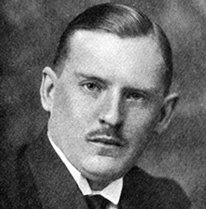
Alexander Alekhine |
|
 (6/17) Review:
Charlie and the Chess Set by
Duane Porter, reviewed by Rick Kennedy. "Children come to
chess along their own individual paths. Some are taught by a friend or
relative. Some learn at school. Some pick it up on their own.
Often a book about chess is involved ... A new entry into the field is Duane
Porter’s Charlie and the Chess Set from Buried Treasure Publishing.
(I keep trying to write “Charlie and the Chocolate Chess Set” – which
would be a whole different story, I’m afraid.) Porter has provided a
warm and endearing "chapter book" which will entice the reader, even as the
main character, 12 year old Charlie, is drawn to and learns about the Royal
Game..." (6/17) Review:
Charlie and the Chess Set by
Duane Porter, reviewed by Rick Kennedy. "Children come to
chess along their own individual paths. Some are taught by a friend or
relative. Some learn at school. Some pick it up on their own.
Often a book about chess is involved ... A new entry into the field is Duane
Porter’s Charlie and the Chess Set from Buried Treasure Publishing.
(I keep trying to write “Charlie and the Chocolate Chess Set” – which
would be a whole different story, I’m afraid.) Porter has provided a
warm and endearing "chapter book" which will entice the reader, even as the
main character, 12 year old Charlie, is drawn to and learns about the Royal
Game..." |
 (6/17)
Review:
101 Chess Endgame
Tips by Steve Giddins (Gambit, 2007), reviewed by Michael Jeffreys.
"Several months ago I reviewed Steve
Giddins’ previous book, 50
Essential Chess Lessons, and thought it was one of the best books of
the year. His latest effort is on the endgame, but before we get into
my review proper I want to say a few words about the book’s layout. It
is formatted like Steve’s 1998 book from Gambit, 101 Chess Opening Traps,
in that each page contains one complete lesson. However, there are
some big improvements. First, the pages are much larger, and now
feature 4-5 diagrams per page rather than the 3 per page as in the 1998
book. Also, the diagrams themselves are larger and thus easier on the
eyes. Additionally, the layout of the text, diagrams, and white space
is much improved, making it a pleasure to go through the material..." (6/17)
Review:
101 Chess Endgame
Tips by Steve Giddins (Gambit, 2007), reviewed by Michael Jeffreys.
"Several months ago I reviewed Steve
Giddins’ previous book, 50
Essential Chess Lessons, and thought it was one of the best books of
the year. His latest effort is on the endgame, but before we get into
my review proper I want to say a few words about the book’s layout. It
is formatted like Steve’s 1998 book from Gambit, 101 Chess Opening Traps,
in that each page contains one complete lesson. However, there are
some big improvements. First, the pages are much larger, and now
feature 4-5 diagrams per page rather than the 3 per page as in the 1998
book. Also, the diagrams themselves are larger and thus easier on the
eyes. Additionally, the layout of the text, diagrams, and white space
is much improved, making it a pleasure to go through the material..." |
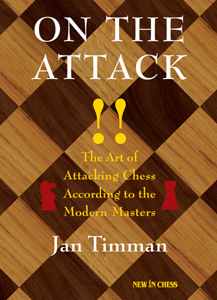 (6/17)
Review:
On the Attack!!
The Art of Attacking Chess According to the Modern Masters by Jan Timman
(New In Chess, 2006), reviewed by NM Bill McGeary. "Beginning
with Art of Analysis,
Timman has endowed the chess community with an enormous amount of material
that is of the highest quality. On the Attack is the latest
contribution of the player once deemed "Best Player in the West" during the
days of Soviet supremacy. The subject of this book,
attacking chess, has always been a favorite for the chess community in
general. Probably that is because we all have a romantic notion to play
like Morphy or Spielmann or Tal. In that regard this book makes it clear
how fortunate players of the 1990's/2000's are that the ranks of top players
include so many fantastic attackers. Timman annotates 3 games by each of 11
players with the design to show how attacking play comes about. Of those
players 2 are of the older generations (Karpov and Timman), one from the
youngest (Volokitin), 3 from the 80's (Kasparov, Short and I. Sokolov) and
the rest from the 90's (Anand, Shirov, Topalov, Ivanchuk and J. Polgar.)
This large number of first class players who strive for the initiative and
attack has not been witnessed on the world scene probably since the end of
Hastings 1895!..." (6/17)
Review:
On the Attack!!
The Art of Attacking Chess According to the Modern Masters by Jan Timman
(New In Chess, 2006), reviewed by NM Bill McGeary. "Beginning
with Art of Analysis,
Timman has endowed the chess community with an enormous amount of material
that is of the highest quality. On the Attack is the latest
contribution of the player once deemed "Best Player in the West" during the
days of Soviet supremacy. The subject of this book,
attacking chess, has always been a favorite for the chess community in
general. Probably that is because we all have a romantic notion to play
like Morphy or Spielmann or Tal. In that regard this book makes it clear
how fortunate players of the 1990's/2000's are that the ranks of top players
include so many fantastic attackers. Timman annotates 3 games by each of 11
players with the design to show how attacking play comes about. Of those
players 2 are of the older generations (Karpov and Timman), one from the
youngest (Volokitin), 3 from the 80's (Kasparov, Short and I. Sokolov) and
the rest from the 90's (Anand, Shirov, Topalov, Ivanchuk and J. Polgar.)
This large number of first class players who strive for the initiative and
attack has not been witnessed on the world scene probably since the end of
Hastings 1895!..." |
 (6/17)
Chess Training: A new "Recon64" Move Prediction Exercise from Jim Mitch (aka Prof. Chester Nuhmentz.)
Today's game is that featured in June's
Chess-Vision exercise, a game between Michael Adams and Veselin Topalov from the
2005 Corus Chess Tournament. Black's
king, uncastled, becomes caught in a relentless attack. Similar to Predict-A-Move and Solitaire-type
chess exercises, Recon64 challenges players to
find candidate moves from games played by
masters. Players are encouraged to search
for several strong candidate moves in each position, and are rewarded as
long as their list of moves includes the move selected by the master during
the game. As an extra twist, players
invest Recon64 dollars on candidate moves based
on how likely they think each move was used in
the original game. (6/17)
Chess Training: A new "Recon64" Move Prediction Exercise from Jim Mitch (aka Prof. Chester Nuhmentz.)
Today's game is that featured in June's
Chess-Vision exercise, a game between Michael Adams and Veselin Topalov from the
2005 Corus Chess Tournament. Black's
king, uncastled, becomes caught in a relentless attack. Similar to Predict-A-Move and Solitaire-type
chess exercises, Recon64 challenges players to
find candidate moves from games played by
masters. Players are encouraged to search
for several strong candidate moves in each position, and are rewarded as
long as their list of moves includes the move selected by the master during
the game. As an extra twist, players
invest Recon64 dollars on candidate moves based
on how likely they think each move was used in
the original game. |
(6/16)
Nuestro Círculo #254:
16 de junio de 2007,
dedicado al Gran Maestro
Internacional ruso Alexander K. Tolush (1910-1969). Aparte de su biografía y
partidas, publicamos una nota sobre las Finales del Torneo de Elista, otra
del Aguafiestas, partidas históricas distinguidas por su belleza y el
Noticiero de Ajedrez.
Nuestro Círculo, un boletín semanal de ajedrez editado en Argentina en lenguaje
español.
|
(6/16)
Alekhine's Parrot:
Welcome to the
weekly leader of chess events around the world.
Chessville welcomes your Feedback to TheParrot on
this week’s news where selected letters will be featured.
This week: New England Masters, Texas Tech Winners,
and Bronx losers. Nakamura, $100,000 Challenges, and
Parrot's Poems. Candidates, Seniors, and Aerosvit.
TheParrot Squaawks about Women in Chess, plus a special
Guest Squuawk by GM Susan Polgar.
|
.jpg)
|
(6/14)
Email Problems: @Chessville.com email addresses have been acting
up the past couple of weeks. The past few days we've been receiving
messages from as long ago as May 24! It appears not to be over either,
as we continue to get messages sent days or even weeks ago. If you've
written us during that period of time and we haven't answered yet - we may
not have received ytour original message. Please resend to make sure
you get a reply. Thanks for your patience as we work through all this
mess...
|
(6/10) Chess Composition:
Peter's Problem World #7 explores the Grimshaw theme.
"As a rule,
good chess problems are required not only to be sound, but to
demonstrate a specific theme or a combination of themes. The appeal
of a problem – the point of it, in fact – lies in these rendered
ideas, which may involve certain recurring motifs or unusual effects.
This month we will focus on the Grimshaw, a theme named after a
19th-century composer who made the pioneering example.
In a Grimshaw, two
pieces of the same color interfere with each other’s line of action,
by playing in turn to a square where the two lines intersect.
Problem 37, an oft-quoted classic, shows three such pairs of
reciprocal interferences.."
|
|
|
 (6/10)
Chess Instruction:
Strategies for Chessplayers and Other Warriors, by Brian Roche.
(From “The Art of War” by Sun Tzu, 500 B.C.) "Assessment
Each new position should be assessed quickly in terms of: 1. Development, 2.
Mobility, 3. Material superiority, 4. Tempo and 5. Space. Strategy
consists of shaping some advantage in terms of these five points.
Whichever side wins more “points” in these areas will probably win the game.
The Art of Deceit When able, seem to be unable. When
close, seem to be far off. If opponent is seeking an advantage, entice
them toward it..." (6/10)
Chess Instruction:
Strategies for Chessplayers and Other Warriors, by Brian Roche.
(From “The Art of War” by Sun Tzu, 500 B.C.) "Assessment
Each new position should be assessed quickly in terms of: 1. Development, 2.
Mobility, 3. Material superiority, 4. Tempo and 5. Space. Strategy
consists of shaping some advantage in terms of these five points.
Whichever side wins more “points” in these areas will probably win the game.
The Art of Deceit When able, seem to be unable. When
close, seem to be far off. If opponent is seeking an advantage, entice
them toward it..." |
 (6/10)
Review:
Beating the
Fianchetto Defences by Efstratios Grivas (Gambit, 2006), reviewed by
NM Bill McGeary. "Chess players for the most part like to put
things in categories; an opening is either aggressive or solid, a game is
either tactical or positional, a move is best or worst. I know this is
an over exaggeration, but the point is that we tend to see things in small
compartments. Opening books are no different, being labeled as
specialized or repertoire books. This book is unique in that it
doesn't break the mold as much as it redesigns the parameters.
"Beating the Fianchetto Defences" is written for players of 1.d4/2.c4 and
deals specifically with the five most popular and dynamic defences.
Grivas adopts a novel approach to presenting the material..." (6/10)
Review:
Beating the
Fianchetto Defences by Efstratios Grivas (Gambit, 2006), reviewed by
NM Bill McGeary. "Chess players for the most part like to put
things in categories; an opening is either aggressive or solid, a game is
either tactical or positional, a move is best or worst. I know this is
an over exaggeration, but the point is that we tend to see things in small
compartments. Opening books are no different, being labeled as
specialized or repertoire books. This book is unique in that it
doesn't break the mold as much as it redesigns the parameters.
"Beating the Fianchetto Defences" is written for players of 1.d4/2.c4 and
deals specifically with the five most popular and dynamic defences.
Grivas adopts a novel approach to presenting the material..." |
 (6/10)
Review:
Dangerous Weapons: the French by
IM John Watson (Everyman Chess,
2007),
reviewed by Rick Kennedy.
"Editor's Note: I have been unable to
contact Mr. Kennedy to correct further this review. However, due to
the importance of the book itself, I felt it my responsibility to present
you with what we have so far. My comments are included below, in blue
text and italicized, to show you just what I've gone through with Mr.
Kennedy over this review. There are rumors, unconfirmed, that he's
locked up in his basement, logged into the Internet Chess Club, endlessly
playing game after game with the black pieces, and aborting all those
not beginning 1.e4. If anyone out there knows Rick, and is
able to make contact with him, please throw some cold water in his face, and
unplug his PC..." (6/10)
Review:
Dangerous Weapons: the French by
IM John Watson (Everyman Chess,
2007),
reviewed by Rick Kennedy.
"Editor's Note: I have been unable to
contact Mr. Kennedy to correct further this review. However, due to
the importance of the book itself, I felt it my responsibility to present
you with what we have so far. My comments are included below, in blue
text and italicized, to show you just what I've gone through with Mr.
Kennedy over this review. There are rumors, unconfirmed, that he's
locked up in his basement, logged into the Internet Chess Club, endlessly
playing game after game with the black pieces, and aborting all those
not beginning 1.e4. If anyone out there knows Rick, and is
able to make contact with him, please throw some cold water in his face, and
unplug his PC..." |
(6/10) Links Update:
Linkmeister Daniel Boyd has been busy updating and eliminating bad links on
the following pages:
Organizations,
Personal Sites,
Players,
Playing Sites, Online Leagues,
General Sites,
Events,
Game Collections,
Discussion Forums & Bulletin
Boards,
Endings,
Publishing,
Reference, Info, & History,
Scholastic,
and
News.
(6/10)
Nuestro Círculo #253:
9 de junio de 2007,
dedicado al Maestro Internacional ruso Ilia
Abramovich Kan (1909-1978). Aparte de la biografía y partidas de aquel
maestro, publicamos una nota sobre el Torneo de Elista, otra de Jorge
Rubinetti, el Noticiero de Ajedrez y seis partidas históricas que fueron
distinguidas por su belleza.
Nuestro Círculo, un boletín semanal de ajedrez editado en Argentina en lenguaje
español.
 (6/3) Review:
Learn the Opening the Easy
Way: The Colle-Zukertort System
DVD, reviewed by
Michael Jeffreys. (6/3) Review:
Learn the Opening the Easy
Way: The Colle-Zukertort System
DVD, reviewed by
Michael Jeffreys.“A player who specialises in
the Colle System needs
to spend only about a tenth of the time studying
the openings that he would otherwise have to.”
– Cecil Purdy
"Learn the Opening the Easy Way
is sort of video version of Susan’s Opening Secrets column that
appeared in Chess Life a few years ago. Each month she would
take a different opening and explain the basic strategic goals for both
sides, then show some games/variations featuring that opening, and then give
her conclusion. (In fact, you can find Susan’s coverage of the
Colle-Zukertort Variation in the May 2006 issue of Chess Life.)
As most of you reading this already know, when you play the Colle Opening
(named after the Belgian master Edgar Colle), you have a major decision to
make on move five. After the moves: 1.d4 d5 2.Nf3 e6 3.e3 Nf6 4.Bd3
c5 do you play 5.c3 (The Koltanowski variation) or 5.b3
(The Zukertort variation)..." |
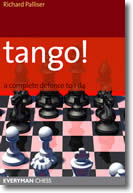 (6/3)
Review:
Tango! A Dynamic Answer to 1.d4 by Richard
Palliser (Everyman Chess), reviewed by Rick Kennedy. "In
1992 International Master Georgi Orlov wrote a small book (CEI, magazine
size, 22 pages) on a largely unknown, but playable, defense 1.d4 Nf6 2.c4
Nc6, which he called “The Black Knights Tango”. The
analysis was based primarily on Orlov’s own game experience, the guidance of
chess coach Moldavian Master Viacheslav Chebanenko, and the occasional
Grandmaster battle (starting with Saemisch - Torre, Baden Baden 1925.)
Six years later, Orlov’s book-length The Black Knights’ Tango (Batsford,
1998) appeared. Enterprising Masters and Grandmasters had jumped upon
the BKT bandwagon, and the author was able to update his analysis, add
games, and lay out the four main variations...Orlov wrote: "After years
of practical experience, and having reviewed all the available material, I
can confidently say that the Tango remains as playable as any other opening
line. It is particularly suitable for club players, since it contains
many interesting opening traps. Many of my students and other players
who have played the Tango at this level have enjoyed plus scores with the
black pieces." So it is a bit surprising that it took another
seven years before a new book on 1.d4 Nf6 2.c4 Nc6 appeared.
International Master Richard Palliser’s Tango! A dynamic answer to 1.d4
is very much worth the wait, however. In short, hang on to the early
BKT monograph for historical reasons, keep the newer BKT’s
book for comparison, but grab this latest Tango with both knights, er,
hands..." (6/3)
Review:
Tango! A Dynamic Answer to 1.d4 by Richard
Palliser (Everyman Chess), reviewed by Rick Kennedy. "In
1992 International Master Georgi Orlov wrote a small book (CEI, magazine
size, 22 pages) on a largely unknown, but playable, defense 1.d4 Nf6 2.c4
Nc6, which he called “The Black Knights Tango”. The
analysis was based primarily on Orlov’s own game experience, the guidance of
chess coach Moldavian Master Viacheslav Chebanenko, and the occasional
Grandmaster battle (starting with Saemisch - Torre, Baden Baden 1925.)
Six years later, Orlov’s book-length The Black Knights’ Tango (Batsford,
1998) appeared. Enterprising Masters and Grandmasters had jumped upon
the BKT bandwagon, and the author was able to update his analysis, add
games, and lay out the four main variations...Orlov wrote: "After years
of practical experience, and having reviewed all the available material, I
can confidently say that the Tango remains as playable as any other opening
line. It is particularly suitable for club players, since it contains
many interesting opening traps. Many of my students and other players
who have played the Tango at this level have enjoyed plus scores with the
black pieces." So it is a bit surprising that it took another
seven years before a new book on 1.d4 Nf6 2.c4 Nc6 appeared.
International Master Richard Palliser’s Tango! A dynamic answer to 1.d4
is very much worth the wait, however. In short, hang on to the early
BKT monograph for historical reasons, keep the newer BKT’s
book for comparison, but grab this latest Tango with both knights, er,
hands..." |
|







.jpg)
 (6/24)
Chess Instruction:
(6/24)
Chess Instruction:  (6/24)
Annotated Game:
(6/24)
Annotated Game:
 (6/24)
Review:
(6/24)
Review:  (6/24) Review:
(6/24) Review:


 (6/17) Review:
(6/17) Review:
 (6/17)
Review:
(6/17)
Review:
 (6/17)
Review:
(6/17)
Review:
 (6/17)
Chess Training: A new "
(6/17)
Chess Training: A new " (6/10)
Chess Instruction:
(6/10)
Chess Instruction:
 (6/10)
Review:
(6/10)
Review:
 (6/10)
Review:
(6/10)
Review:
 (6/3) Review:
(6/3) Review:
 (6/3)
Review:
(6/3)
Review: